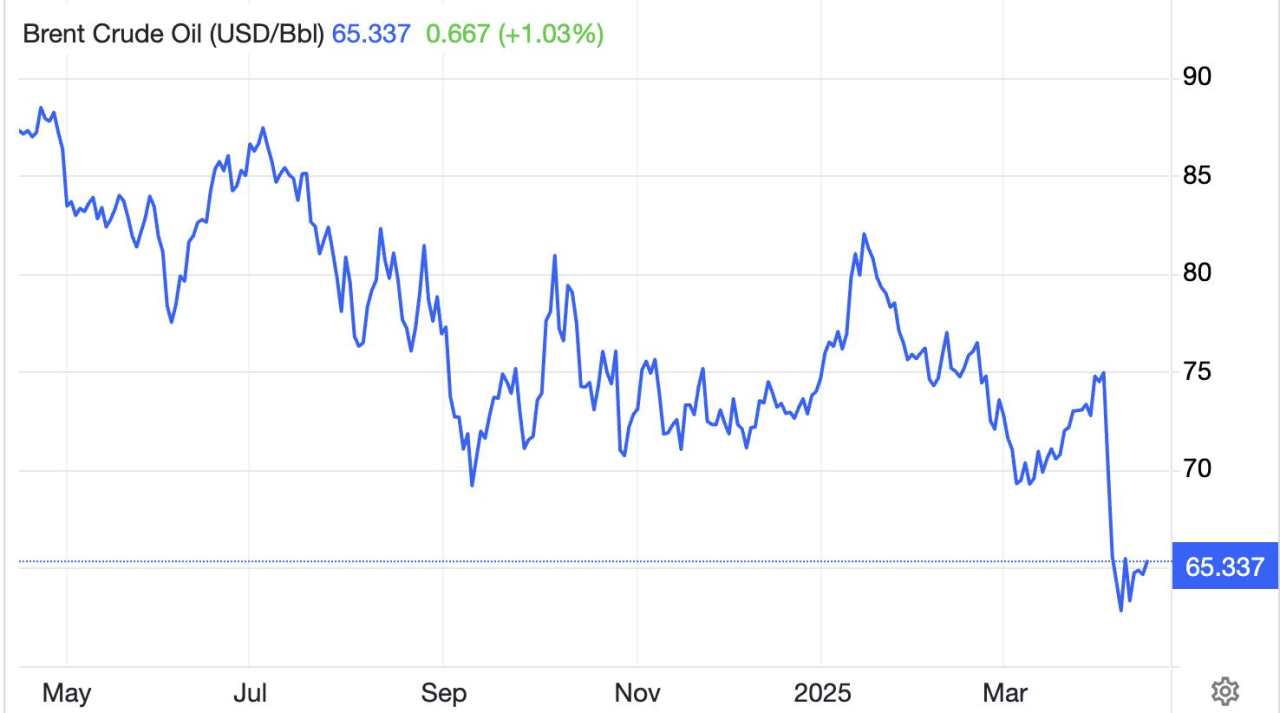Oil prices continue to slide, deepening the losses seen last week as concerns over global trade tensions and a growing oil supply weighed on market sentiment. U.S. West Texas Intermediate (WTI) crude fell $1.29, or 2.08%, to settle at $60.70 per barrel, while Brent crude dropped $1.37, or 2.09%, closing at $64.21. At the time of writing, Brent crude was trading at $64.48 and WTI at $61.13, reflecting modest intraday recoveries.
Both benchmarks remain down more than 10% over the past week, with WTI briefly touching an intraday low of $58.95 - the lowest level seen since 2021. Brent also touched a low of $65.33

Source: Tradingeconomics
The price drops came even as China reported stronger-than-expected GDP growth of 5.4% for Q1 and March oil imports at a robust 12 million barrels per day - its highest since August 2023.
Still, the broader pressure on oil prices remains, driven by rising inventories and uncertain trade dynamics.
Inventory builds reinforce bearish sentiment
New inventory data further soured sentiment in oil markets. The American Petroleum Institute (API) estimated U.S. crude oil inventories rose by 2.4 million barrels for the week ending April 11, surprising analysts who had expected a drawdown of 1.68 million barrels. This follows a 1.057 million-barrel drop the prior week, putting the year-to-date inventory build at over 24 million barrels.

Source: API
Cushing inventories - the benchmark stockpile at the key delivery point for U.S. crude futures - increased again, rising 349,000 barrels after a 636,000-barrel build the week before. Meanwhile, the Department of Energy reported a 0.3 million-barrel increase in the Strategic Petroleum Reserve (SPR), bringing the SPR total to 397 million barrels - still well below pre-withdrawal levels.

Source: SPR
Although gasoline inventories fell by 3 million barrels and distillates dropped by 3.2 million barrels - both indicating healthy refined product demand - the overarching build in crude inventories is keeping pressure on the broader market.
Tariff pause brings partial relief, but uncertainty lingers
President Donald Trump’s decision to pause tariffs on countries that haven’t imposed retaliatory measures offered brief relief to financial markets. Goldman Sachs lowered its near-term probability of a U.S. recession, citing the move as a sign of temporary de-escalation. But China - central to the trade tensions - was excluded from the tariff pause, maintaining a high level of uncertainty in global trade relations.
China’s Q1 economic performance came in stronger than expected, but analysts remain cautious. Xu Tianchen of the Economist Intelligence Unit noted that China has posted strong first quarters in recent years, only to lose momentum in the following quarters. “A forceful and timely policy response” will be needed to limit the impact of trade conflicts, he said.
Even as China ramps up oil purchases from Iran and Russia, questions linger about the sustainability of demand, especially as traders continue to navigate U.S. sanctions on those exporters.
Supply growth keeps the market on edge
In addition to demand-side risks, the supply side isn’t offering any relief. OPEC+, including Saudi Arabia and Russia, recently announced plans to accelerate output increases—an unexpected move amid already fragile market conditions.
Saudi Aramco also lowered the official selling price of its Arab Light crude for Asian customers, a signal of weakening refinery demand in the region. Such price cuts often foreshadow further softness in physical markets.
Goldman Sachs responded by cutting its year-end oil price forecast, now expecting WTI to average $58 per barrel (down from $62) and Brent at $62 (down from $66). The bank also warned that prices could drift lower in 2026, citing a persistent surplus estimated at 1.25 million barrels per day.
The price slump is beginning to pinch U.S. shale producers. Jeff Currie, chief strategy officer for energy at Carlyle, noted that WTI at $60 is already below break-even for some operators. If prices fall below $55, output from the Permian Basin- the heart of U.S. shale -could start to decline.
“The downward trend for oil prices remains intact,” said IG analyst Yeap Jun Rong. “We may expect initial optimism around tariff rollbacks to fade, and the underlying macro headwinds on upcoming economic data could bring markets back to a more sobering reality.”
Technical outlook: Still cloudy
While some price stabilization occurred late in the day - likely fueled by China’s upbeat data - analysts and traders still await more evident signs of demand recovery or coordinated supply discipline. Until then, the oil market remains under pressure, caught between swelling inventories, shaky macroeconomic signals, and unresolved geopolitical friction.
At the time of writing, oil prices are in a consolidation mode, with RSI almost flat below the midline and price hovering in mid-Bollinger bands- hinting that momentum is quite low and in a wait-and-see mode before any significant swings. Prices hovering below the moving average suggest that sellers are still in control.
Key prices to watch should prices slump further are $59.66 and $57.31. Should prices see an uptick, buy pressure could find a resistance wall at the $63.61 and $68.52.

Source: Deriv MT5
作者:Prakash Bhudia,文章来源FXStreet,版权归原作者所有,如有侵权请联系本人删除。
风险提示:本文所述仅代表作者个人观点,不代表 Followme 的官方立场。Followme 不对内容的准确性、完整性或可靠性作出任何保证,对于基于该内容所采取的任何行为,不承担任何责任,除非另有书面明确说明。


暂无评论,立马抢沙发